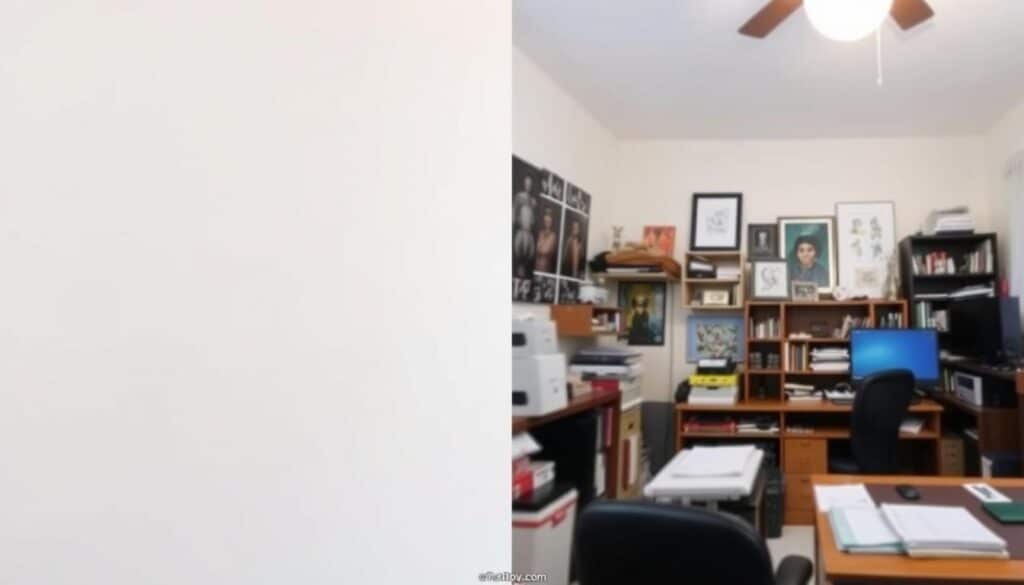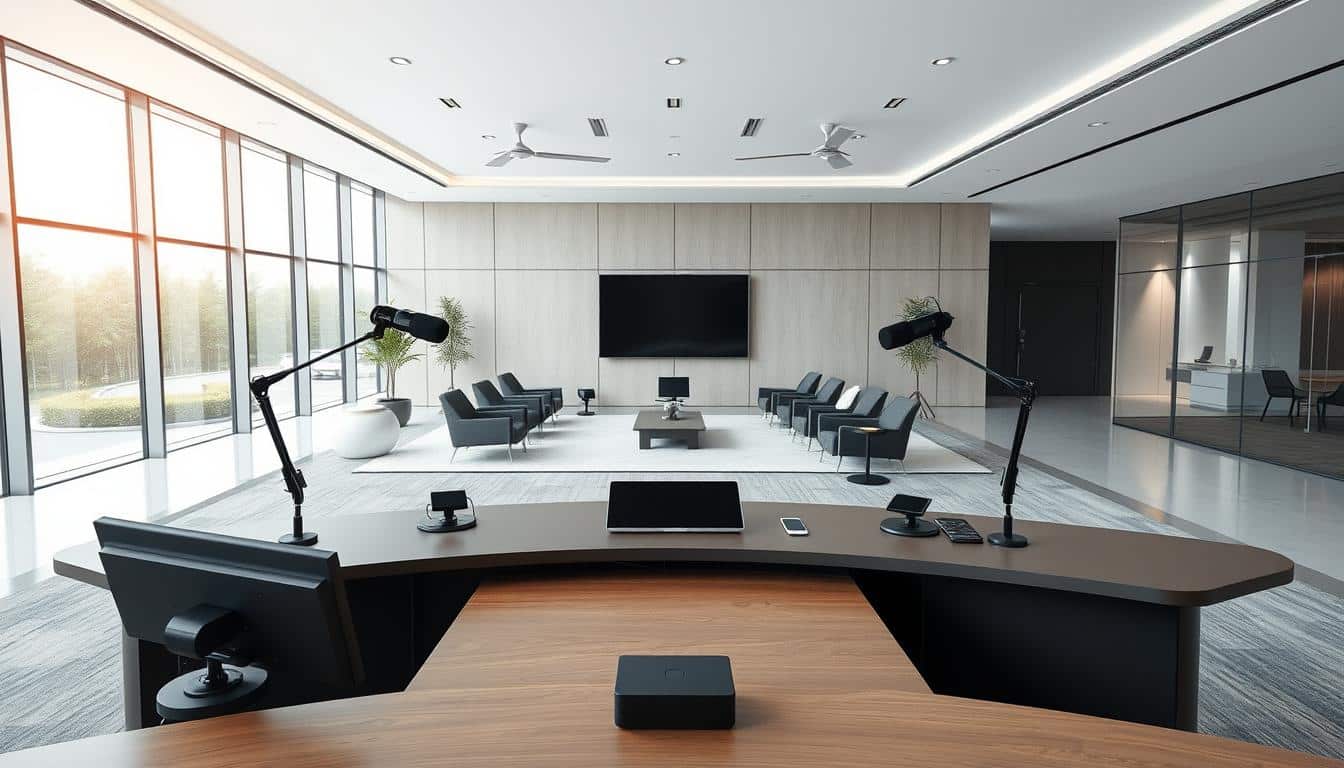Online meetings are now a key way we talk at work. Choosing the right camouflage background is very important. Using the right virtual backgrounds makes you look better and more professional. This impresses your coworkers and clients. You can upload your own pictures in JPG, PNG, or GIF formats. This makes you stand out in online meetings. It helps reduce distractions and keeps everyone focused.
Using backgrounds correctly is crucial, whether you’re at home or with others. You can use virtual backgrounds on computers that work with Remo. To make your background look good, use images with a resolution of 1366 x 768 pixels. Also, keep the file size under 3 MB. If your background doesn’t look right, try blurring it as a quick fix.
Anúncios
Adding great images from Pexels or Unsplash can make your online look better. You can also create your own backgrounds with Canva. As online meetings get more common, knowing how to look your best is vital. It helps you look professional and keeps meetings productive.
Understanding the Importance of Backgrounds in Online Meetings
Backgrounds in online meetings are very important. A well-chosen background makes a big difference in how people see you. If your space looks tidy and professional, you seem more credible. But, a messy background can distract from what you’re trying to say.
Good lighting is key to look professional online. Don’t sit with a window behind you; it makes you hard to see. Choose a background that fits the meeting theme. This helps keep the talk relevant and focused.
A good contrast between your background, skin, and clothes makes you stand out. Use high-quality images to look your best online. Websites like Canva and Unsplash are great for making custom backgrounds that fit your style.
There are many options for online meeting backgrounds. Using a green screen lets you add any backdrop you want. Just don’t wear green, or you might disappear into it. Softly blurring your background can make people pay more attention to you, not where you are.
Real-life backgrounds feel personal but might not look professional. Blurry backgrounds focus on you but can feel fake if done wrong. Virtual backgrounds show off your brand but might feel too cold.
Try mixing real and virtual elements for a unique background. This way, you stay true to yourself while looking professional.
Your Online Image and Perception
Your online image is key when managing how others see you during video calls. Like in old-time portraits, your background says a lot about you. A well-chosen background shows you’re serious and trustworthy, making a big difference in how people view you. For example, having plants or a bookshelf behind you makes you seem more reliable and smart.
On the other hand, messy rooms or funny wallpapers might make you look less professional. These distractions can hurt how others see you in online meetings. Picking a simple background, like a plain wall, keeps everyone focused on what you’re saying. It also helps avoid ‘Zoom fatigue’ by keeping things clear and simple.
Adding small, personal items like a plant or a tidy shelf can make your online space look better. Good lighting is also important, whether it’s from the sun or a lamp. And make sure your camera is right at eye level. This makes your setup more inviting. All these steps help you come across as genuine and confident.
Choosing the Right Background
Choosing the right background is key to good online communication. Horizontal images can improve the look of your video calls. Make sure these images are 1920 pixels wide and 1080 pixels high for clear visuals.
Utilizing Horizontal Images for Backgrounds
For your background, pick horizontal images that add to the mood of your meeting. Use images like private offices or cozy rooms to make things professional yet inviting. There are over 400 backgrounds for Zoom, covering many settings like workspaces and rooms.
Avoiding Distracting Elements
It’s important to keep online meeting backgrounds simple. Busy or complex backgrounds can take attention away from you. Choose simple designs and avoid clothes that blend into your background to stop weird visual effects. For work meetings, pick neutral, business-like backgrounds to keep things professional.
How to Camouflage Background for Online Meeting
Camouflaging your background improves your online meeting. Use software to get a professional look. Camo, Zoom, and Microsoft Teams offer virtual backgrounds for any style. Choose the right background to focus on you, not distractions.
Utilizing Software Tools for Virtual Backgrounds
Software turns plain backdrops into professional ones. Zoom has a feature for videos or still images as a background. It hides real-life messes perfectly. But, you need a good computer, like one with Intel Core i5 or i7. If not, a green screen might be necessary.
To use this feature, go to the “Virtual Background” settings. There, you can pick a background or upload your own.
Creating Cohesion with Your Presence
Matching your background with your style makes you look polished. Go for backgrounds with good contrast and lighter colors for visibility. Stay away from busy or detailed backgrounds that could distract.
Be careful with realistic backgrounds too. They might make viewers lose focus. Follow these tips to make your online persona stand out and look professional.
Lighting Techniques to Enhance Background Visibility
Good lighting is key to making your background look better in online meetings. If the lighting is bad, even the best backgrounds will seem dull. Using natural light well can make your online look more professional and memorable. Try to work near a window to use daylight, but avoid direct sun to prevent shadows and glare.
If you don’t have enough natural light, a ring light is a great choice. It gives off an even light, reducing shadows on your face and background. Don’t put lights directly behind you as it can hide your background and create a shadow of you. Lights should be placed at a 45-degree angle from you to show depth and keep the background details clear.
Add diffused light to make your videos look better. This kind of light softens shadows for a nicer look. Use a two-point or three-point lighting setup to spread the light evenly. Lights with diffusers or frosted glass help lower glare and show your background better.
Match the color of your lights to the room’s natural light for a professional look. Try different brightness settings to get the background just right, not too bright or dark. Use a tripod or stand to adjust your lights easily for the best visibility.
By using these lighting tips, you can greatly improve how your online meetings look. This ensures your background enhances your professional image.
Simple vs. Busy Backgrounds
Choosing the right background is key in online meetings. Busy backgrounds might catch the eye but can distract from the speaker. Simple backgrounds, on the other hand, keep everyone’s attention on what’s being discussed. This is especially true for meetings about learning or technical topics. Picking the right background style depends on what the meeting is about and who’s watching.
When to Use Each Style
Simple backgrounds are ideal for many situations, like formal talks or learning sessions. Colors that soothe, such as cream, light blue, and grey, help listeners focus on the speaker without getting distracted. This is perfect for discussions where it’s important to be clear.
Busy backgrounds have their place too. They can show off a speaker’s personality or highlight their creative brand. But it’s important not to go overboard, as too much detail can distract. Virtual backgrounds are a good option here. They can be customized to look professional without being overwhelming.

Keeping your space neat is important because a messy area can give the wrong impression. Using custom or peaceful images, like stars or empty beaches, can personalize your background while still looking good. Generally, picking a simple background is better. It keeps things professional and helps you get your message across without distractions.
Best Practices for Personalizing Your Online Background
Personalizing your online background helps establish your brand in a professional way. A good backdrop enhances your image and connects with your audience. This is key for successful online meetings.
When choosing your background, keep these points in mind:
- Use simple colors like grey or blue for a professional look. Avoid stark white or black due to harsh contrasts.
- Add personal items like family photos or artwork to show your personality. This makes you relatable but keeps things professional.
- Use branding like school logos if it fits. It keeps your online look consistent.
- Stay away from controversial items in your background. This ensures everyone feels welcome.
- Adding a plant can make your space look lively. Greenery helps make the space inviting and keeps people interested.
There are technical tips for choosing a virtual background too. Use design tools like Canva or Adobe Spark for high-quality images. Aim for a resolution of 1920×1080 pixels and keep file size under 5MB. A virtual background also adds privacy when you have personal items around.
Changing your background on platforms like Zoom is easy. Go to settings, pick your image, and adjust as needed. This lets you customize while staying professional in online meetings.
Improving Background with Color and Lighting
Choosing the right colors and lighting for online meetings can really change how you come across. By picking good colors and improving light, you make a big difference in how things look. Colors that match well can make a nice visual that makes people focus on you. At the same time, using colors that stand out helps the speaker be more noticeable. Good lighting can also make the colors in your background look better, which makes everything look more professional.
Using Color Theory for Professional Appeal
It’s super important to understand color theory for setting up your background. Colors can send different feelings and messages, changing how people see you. Here’s what to keep in mind:
- Pick colors that show who you are or what your work’s about for a consistent look.
- Try to sit near a window to use natural daylight for better lighting.
- Add a ring light to brighten up the place, which lets you change how warm or cool the light is. A good one is about $150.
- Don’t have light coming from behind you. It can make shadows on your face and make it look dark.
- A grey wall works great with colored lights and helps balance the background.
- Use lights like Philips Hue spotlights away from the camera to add depth and texture without being distracting.
Test your setup with tools like Zoom’s self-view to make sure your lighting and background look great. Using color and lighting well lets you create a background that’s not just nice to look at but also boosts how you want to be seen.
Conclusion
In today’s world, having a good online background is key to looking professional in meetings. A smart virtual setting shows you’re serious and affects how others see you in online meetings. Tools like Google Meet’s background blur help you look neat online, mixing privacy and professionalism.
Choosing the right images, having good lighting, and adding a personal touch are also important. With Google Meet, you can pick a light or strong background blur. This focus is on you, not what’s behind you. A blurred background keeps everyone focused and helps in having better meetings.
Using these tips can improve how you appear online and show you’re organized and focused. The right background makes a big difference, whether it’s a casual talk or a formal meeting. As we keep working remotely, it’s smart to pick your online backgrounds carefully to show your best professional side.
FAQ
Why is the background important in online meetings?
What types of backgrounds work best for virtual meetings?
How can I customize my virtual background without losing professionalism?
What tools can I use to create effective virtual backgrounds?
How does lighting affect my online meeting background?
When should I use a simple background versus a busy one?
How can color choices impact my online presence?
What mistakes should I avoid when selecting a virtual background?
Conteúdo criado com auxílio de Inteligência Artificial



